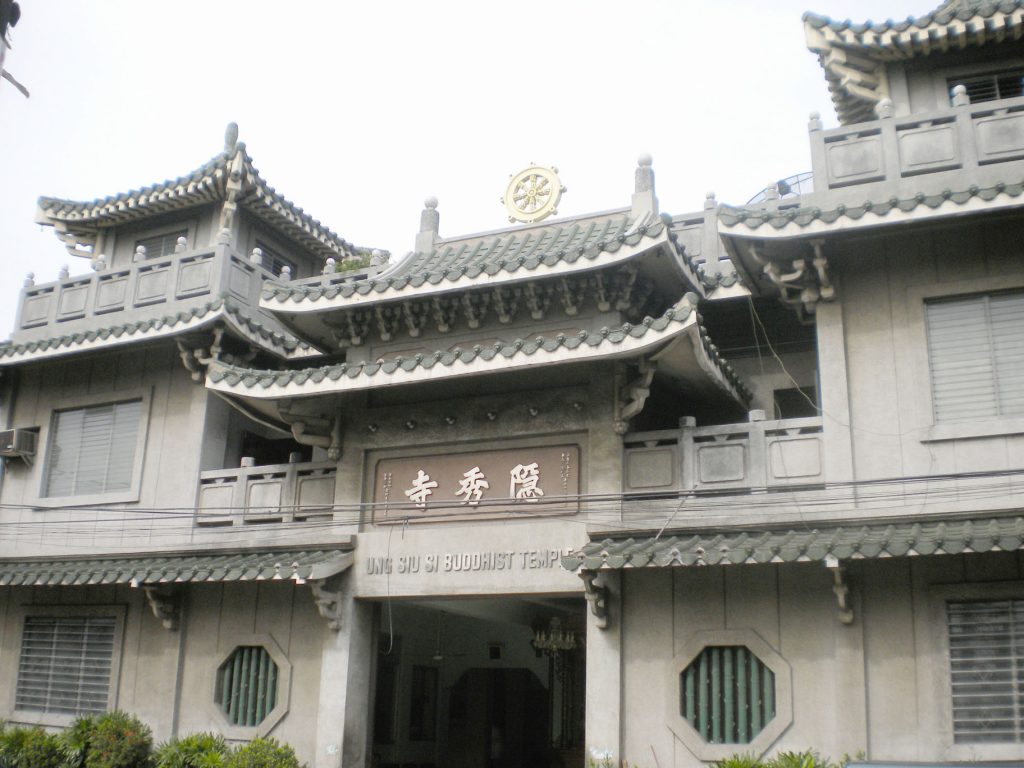Editors Note: This is the 24th of a series about the 36 Chinese Buddhist temples of the Philippines. Much of the information is from a thesis of Venerable Chuanmiao (Hsuan Chuang University, 2008), a Buddhist monk affiliated with the Thousand Buddha Temple in Quezon City.
24. Un Siu Temple 隱秀寺
193 J. Teodoro cor. 6th Ave. Grace Park, Caloocan City
Tel.: 361-9375 • 361-9376
This temple was founded by the lay sister Qinghe (清和), born in 1890 in Nan’an (南安), Fujian, to a devout Buddhist family. She was vegetarian from birth and became a lay sister at 14. She made a pilgrimage to Mt. Putuo (普陀山) in 1911 and took refuge and learned the five precepts at the Yinxiu Temple (隱修寺).
In 1915, she took the bodhisattva vows at the Puji Temple (普濟寺), also in Mt. Putuo.
She came to Manila in 1917 to raise funds, but decided to stay and propagate Buddhism. She brought a statue of Guanyin from the Yinxiu Temple in Mt. Putuo and established a small private shrine on Juan Luna Street.
Devotees increased, and in 1949 Qinghe bought the Caloocan property to start a bigger temple. Construction and interior design took several years. A major cause of delay was a neighboring fire that damaged parts of the new temple. The temple was completed in 1957.
In 1962, Qinghe invited Master Zili (自立), who was teaching the Buddhist education classes at Samanthabhadra Institute (普賢中學) – a primary and secondary private Buddhist school – to be Master Teacher at her temple. Its Taixu Lecture Hall (太虛講堂) was established that year.
Zili was from Taizhou (泰州) in Jiangsu province. He did not speak the Hokkien dialect, only a heavily-accented Mandarin. He went to Taiwan with other monks in 1949 and studied under Master Cihang (慈航).
In 1954, Liu Meisheng (劉梅生), the Principal of Samanthabhadra Institute invited him to return and teach Buddhism at the school.
When Qinghe died in 1980, Zili became the abbot. He did major renovations in 1984 to improve all the temple shrines. He also started the Tze Hang (Cihang) Free Clinic in 1991.
Two of his former students at the institute renounced under him and became the nuns Fajing (法淨) and Falian (法蓮).
Zili died in December 2010, and the two nuns continue to look after the temple and its activities.

Main buildings. The building has two floors. The spacious and well-laid out ground floor has Maitreya and Ksitigarbha shrines at the entrance, flanked on both sides by ancestral altars, one for spirit tablets of the devotees’ deceased relatives, and the other for the temple’s founder. The inner hall is the Taixu Lecture Hall which also doubles as the dining hall.
The shrine to the three Buddhas is on the second floor, and on the other end of the floor is the shrine to Guanyin, a sitting area, library, and offices. Living quarters are also on the second floor.

Leadership and primary activities. As Zili’s health declined and especially after his death in December 2010, his disciple Fajing has been managing temple affairs together with Falian. Aside from the first day and 15th of each month, the 23rd is the temple’s unique devotion day, and major feast days of the month are usually observed then.
The temple is unique for chanting services that last only one hour, to give way to a short lecture before lunch is served. Carried out three times a month, this is a legacy of the learned monk Zili who wanted to facilitate Buddhist learning as against ritualistic Buddhism. Fajing and lay devotees, all former students of Zili, take turns giving lectures.
In the 1960s, the temple published a magazine called Cihang, but this was discontinued when the Philippine government declared martial rule in 1972. Starting in 1997, the temple published several works by Zili for international distribution.
The Cihang charity clinic operates every Saturday. — First published in Tulay Fortnightly, Chinese-Filipino Digest 25, no. 23 (May 21-June 17, 2013): 14.
